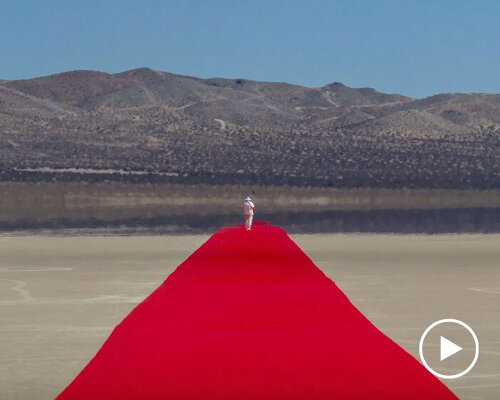El Mirage: a red line path unfurls across the California Desert
El Mirage is a site-specific installation by artist Gregory Orekhov, located on the dry lakebed of El Mirage in California. The work consists of a one-kilometer (3,000-foot) red polypropylene strip, unfurled along an east–west axis that mirrors the path of the sun from sunrise to sunset. The land art installation establishes a precise geometric intervention within the desert’s cracked surface. By tracing a linear path through the open terrain, the work creates a direct visual and spatial dialogue between human scale and the vastness of the surrounding landscape. Throughout the day, the appearance of the red line changes in response to shifting light conditions. At sunrise, it appears sharply defined; at midday, its edges soften against the reflective surface; and by evening, it catches the low sun, taking on a luminous quality. These temporal variations emphasize the connection between the work’s orientation and the cyclical movement of natural light. Photographers Rafael Gamo and Studiolandon capture the installation’s shifts throughout the day.
all images by Rafael Gamo unless stated otherwise
Gregory Orekhov’s red line reinterprets the passage of time
The project extends Orekhov’s ongoing exploration of linear form and spatial continuity. The red line serves as both a measurable element within the landscape and a marker of duration, a physical representation of passage across time and terrain. El Mirage also relates to the artist’s earlier installation Nowhere (2022), presented in Malevich Park, where a red line extended across a snow-covered forest. While both works share a formal simplicity, their contexts alter the perception of the gesture: in the forest, the line was a temporary trace fading into white; in the desert, it becomes a structural axis that defines orientation and presence. El Mirage positions the landscape itself as a central component of the composition. The installation bridges environmental observation and conceptual expression, reflecting on how a single line can redefine perception of distance, direction, and human relationship to space.
a one-kilometer red line stretches across the dry lakebed of El Mirage, California
the installation by Gregory Orekhov follows an east–west axis aligned with the sun’s path
the red polypropylene strip forms a geometric gesture across the cracked desert floor
a dialogue emerges between human scale and the expansive horizon
the work introduces a linear intervention within the vast, open landscape
by midday, heat and light blur its edges into the shimmering surface
at sunset, the strip glows with reflected light, merging with the horizon
the project explores how natural light transforms perception throughout the day | image by Studiolandon
the red line operates as both a physical and temporal marker in the landscape | image by Studiolandon
Orekhov’s intervention transforms an empty terrain into a spatial composition
El Mirage continues the artist’s study of linear form and spatial continuity
the simplicity of form contrasts with the complexity of its environmental context
the surrounding landscape functions as an integral part of the composition
El Mirage redefines how space, direction, and time are perceived | image by Studiolandon
project info:
name: El Mirage
artist: Gregory Orekhov | @gregory.orekhov
location: El Mirage, California, USA
photographer: Rafael Gamo | @rafael_gamo, Studiolandon | @studiolandon
designboom has received this project from our DIY submissions feature, where we welcome our readers to submit their own work for publication. see more project submissions from our readers here.
edited by: christina vergopoulou | designboom
The post one-kilometer red line land art installation by gregory orekhov spans across california desert appeared first on designboom | architecture & design magazine.

